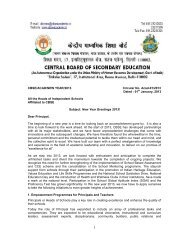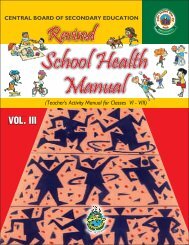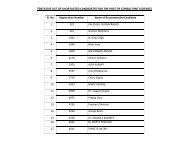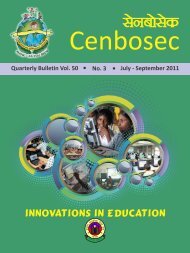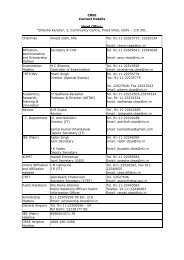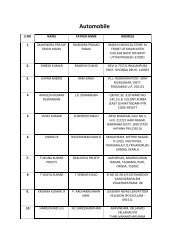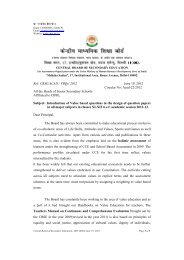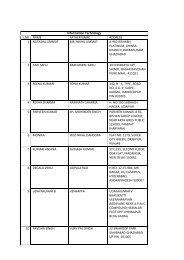CCE Manual VI - VIII - CBSE
CCE Manual VI - VIII - CBSE
CCE Manual VI - VIII - CBSE
Create successful ePaper yourself
Turn your PDF publications into a flip-book with our unique Google optimized e-Paper software.
Continuous and Comprehensive Evaluationtowards assessment tasks which emulate the kind of process-based higherordertasks thought to represent good practice.Continuous assessment is a balance between the undesirable extremes ofincessant (e.g. daily) and quantum (e.g. annual) assessment.In implementing a program of continuous assessment, teachers need to providesufficient but not an excess of formative assessments to allow students to developresponse techniques for the range of assessment instruments and conditionsthat will be applied. When scheduling assessment tasks teachers need to beaware of the stage and rate of development of students to help ensure thatthere has been adequate time for students to learn sufficient subject content, sothat assessment of understanding and application is grounded in that knowledge.While continuous assessment makes demands on teachers, it also allowsteachers the flexibility to meet them. By spreading assessment decisions overboth time and tasks, not only is the evidence used to support judgments increased,so too are the opportunities for reflection on those judgments. Teachers candivide assessment into suitably timed and sized parts in such a way that the timeallowed is less likely to be a covert criterion of assessment quality. Furthermore,the time frame involved in continuous assessment is an important aspect ofputting together student records and providing time for teachers to reflect onthe assessment and its outcomes. Continuous assessment also provides, in away that terminal evaluation cannot, both motivation and opportunities forstudents to reflect on their work, develop strategies for improvement, anddemonstrate improvement before the final (summative) assessment is made.Nevertheless, the difficulties involved for teachers in meeting the challenges posedby continuous assessment should not be understated. Experiences elsewhereshow that continuous assessment makes time-management demands onteachers and students, it can lead to over-assessment, and it can create tensionsbetween the formative and summative purposes of assessment.This manual includes some useful ideas on changing assessment practices.The various forms of formative assessment suggested in the manual seem capableof assessing a greater range, at least, of curriculum learning than do externalexaminations. Various distinctions are made in the manual as internal versusix





